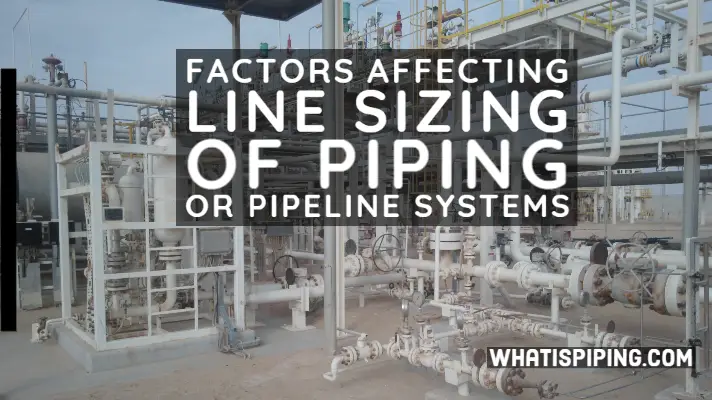Gas piping is basically natural gas piping used widely in common households. The gas piping system carries natural gas from the supply to household ovens or heating systems. The complete gas piping system consists of branch lines that distribute natural gas to individual appliances throughout the home and drop lines. Proper working of gas piping is crucial for the safety of mankind and properties. In this article, we will learn about gas piping systems, their working, materials used, and types.
The piping or lines that supply natural gas inside the house is known as a gas supply line or building line. Supply lines transfer the gas to branch lines that run to individual appliances. The branch lines terminate in a vertical drop-down pipe known as a drop line which connects to the appliance. The gas piping system also has drip legs or sediment traps at the appliance connection point.
Working of Gas Piping Systems
The flow of natural gas through the gas piping systems relies on the internal pressure inside the piping system. It is well-known that gas flows from higher to lower pressure. After the extraction of the natural gas, it is transported through a long highway-like piping system that ends up in the distribution systems to bring the gas into a common household.
The distribution line is also known as the main line. Natural gas from the mainline runs into the service lines. Beyond these service lines, gas supply lines and equipment are connected. A pressure regulator controls the pressure of natural gas entering any individual household. The gas pressure is kept slightly higher than the atmospheric air pressure so that the gas flows out of the burner and into the heating to ignite it.
Materials for Gas Piping
For distributing natural gas, a range of materials are available. The most common gas piping materials are Galvanized Steel, PVC, black iron, HDPE, Copper, Aluminum Plastic Composite, Stainless Steel, etc. Local guidelines must be followed when deciding the ideal material for the specific gas piping system.
Flexible Corrugated Stainless Steel Tubing: This type of gas piping system is highly flexible and easy to install. In high-risk locations of natural disasters, flexible stainless steel works well. The flexibility of corrugated tubing minimizes damage and is widely used for indoor gas piping systems.
Galvanized Steel: Galvanized steel gas pipes are energy efficient, versatile, and durable. they find applications in both interior and exterior gas lines. However, as galvanized steel gas pipes are labor-intensive, they are not generally used in new constructions.
Black Iron Gas Pipes: This is the most common material for gas pipes. Used both in interiors and exteriors applications, this type of gas piping system is strong, heat resistant, and can form an airtight seal. However, black iron gas piping systems must be maintained regularly as they are prone to corrosion and their sealant can deteriorate.
PVC Gas Piping System: Due to their high corrosion resistance and durability, PVC gas pipes are widely used for underground exterior gas lines. PVC pipes are economic but need careful installation to avoid breakage.
HDPE Gas Pipes: HDPE pipes are also a good choice for underground exterior gas lines. HDPE gas pipes are flexible and relatively inexpensive.
Copper Gas Piping System: They find only limited use as some municipalities do not allow it. Copper gas pipes have strict code requirements and are usually designed for a 20 years life.
Aluminium-plastic Composite Pipe: They are a composite of polyethylene and aluminum. The inside is aluminum whereas the polymer is bonded outside using adhesives. Suitable for transporting both liquids and gases, this type of gas pipe is corrosion-resistant and handles relatively high temperatures.
Problems with Gas Piping
One of the main problems with gas piping is leakage which may cause poor air quality, fires, and even explosions. So, the gas piping system must be inspected and maintained regularly to check for potential problems.
Common signs of gas piping problems are:
- Improper connections
- Leaks
- Rusting
- Inadequate support
- Missing shut-off valve
- Hissing sounds
- Plastic pipe exposed above grade
- Issues with gas-powered appliances
- Rotten egg smells
- High energy bills
- No drip leg
- Inappropriate materials
- Copper tubing is not properly labeled
- Piping in chimneys or duct systems
So it is always suggested to be cautious and follow the following safety guides:
- Turn off all gas mains before starting work.
- Use the right kind of safety harness (gloves, a hard hat, boots, and reflective clothing) while working. If you detect a rotten egg smell (natural gas leaking), immediately get out of that place.
- Barricade excavations while working underground gas pipe installation.
- Use correct tools for gas pipe handling.
- Ensure proper sign and warning conventions to inform others about the ongoing work.
Gas Piping Legislation
All gas piping must follow the local fuel gas legislation and the design of the gas piping system must be 100% compliant. All the guidelines must be followed which are usually developed based on various international codes like the building code, the plumbing code, the fire code, the property maintenance code, the residential code, the mechanical code, the fuel gas code, etc.
Gas Piping Size/ Natural Gas Pipe Sizing
Gas piping size or natural gas pipe sizing may vary depending on the fuel gas code of that locality. In general, gas pipe sizing depends on various parameters as listed below:
- Total connected gas load
- The longest length of the gas piping in the building.
- Horizontal and vertical distances between the meter and the longest fuel-burning appliance.
- The material of the gas pipe being proposed
- The pressure inside the building.
- The applicable Fuel Gas Code. There will be different tables in the fuel gas code depending on gas pipe materials.
Once these parameters are known, the Sizing of natural gas pipes is done following specific tables mentioned in the relevant fuel gas code. A typical natural gas pipe size chart can be accessed by clicking here.








